From the tundra to London, from a homemade tattoo machine to a unique artistic style that can't be mistaken — the journey of Denis, known as MARADEN, goes far beyond the typical biography of a tattoo artist. His visual language is clear, memorable, and instantly recognizable: a black and red palette, minimalist forms, symbols that speak at first glance. But behind this precise form is a man with a deep internal architecture — strong, reflective, and unlike anyone else.
His works are easy to recognize — but to truly read them, you need to get to know the artist himself. In this interview, Maraden reveals himself not only as an artist but as a person with an unusual life story, his own rhythm, and worldview. You're about to read a conversation about style, pain, childhood beyond the Arctic Circle, a fire that never dies, and dreams that become projects. If you're ready — let's begin.
— Denis, hi! We've been following your work since 2017, back when you were working in Saint Petersburg. At that time, black was dominant in your tattoos. What else, besides color, has changed in your style over the years?
— Hi, Inkppl! Red has been present in my work from the very beginning — since 2012, when I started forming my style. Back then, it was more about traditional tattoos, but already in a black and red palette, with small elements hiding the outlines.
If you don't evolve, you'll just stay in the past.
Since then, the style has constantly evolved — from simplification in 2018–2019 to rich detailing and red fill by 2021. I'm always revising, removing the unnecessary. You can’t stand still now — the world has sped up.

— Let’s go back to the beginning. How and when did you get into the tattoo industry, and what pushed you toward tattooing?
— I loved drawing since childhood. It was the 90s — the era of “cool guys” movies with tattoos, like Blade or From Dusk Till Dawn. That made a big impression on me — I used to buy temporary tattoos and stick them on, imagining I was as cool as those movie heroes.
In the early 2000s, my older brother got a tattoo at home from a local artist — and that was the final spark. At 14, while finishing art school, I built a homemade machine using a motor, a pen, and a needle — and gave myself my first tattoo. My grandma wasn’t thrilled.
Later I bought real equipment and started tattooing my friends. The internet was barely a thing, so it was hard to find information. From 2010, I began working professionally in a studio.

— Do you have a formal art education?
— Yes, I’ve attended art school since early childhood. It was a great time — after regular school, going to art classes, because I truly loved to draw.
I’m really grateful to my teachers for the huge foundation they gave me. That experience has proven invaluable — both for drawing and later for tattooing. I believe every tattoo artist should study the basics of drawing and composition, at least on a fundamental level — it really helps in the work.

— Tell us how your style developed. Why did you choose red as the dominant color?
— In 2012, I moved to Saint Petersburg and got a job in a high-volume studio. At first, there weren’t many clients, so I had a lot of free time to create designs.
I made a few flash sets in a black and red palette — simply because I had bought my favorite colors: black, red, and gray. They sold quickly, and I gained my first regular clients.
At the same time, I kept working in different styles, but always returned to black and red graphics. I gradually removed outlines — especially in red areas, where they overwhelmed the look. Eventually, I got rid of them entirely.
Later, I started building visual identity: using recurring elements so that my work would be easily recognizable. Skull, flower, fire, figure — each element has its own design logic. I needed this to form a consistent visual language that would make my tattoos instantly identifiable. Now I can immediately spot when someone uses my elements or copies the style completely — and I usually just block those people.
— Your portfolio is filled with emotionally charged themes: loneliness, unrequited love, pain, and death. Do you feel a therapeutic effect from expressing such intense emotions on your clients' skin?
— My work indeed features many themes — loneliness, unreturned love, death. But I don't assign specific meanings to them — I leave interpretation up to the viewer. To me, they’re more of an ironic reminder: all of this is a natural part of life, just like joy and love. There's no need to fear it.
My visual language was largely shaped by my personal story and the place where I grew up.
I was born and lived until the age of nine in Dudinka — a small northern town beyond the Arctic Circle. There were many abandoned and unfinished buildings — a result of the 90s crisis. All around — tundra, endless snowy fields, depression, and gloom. Winter lasts nine months a year, and during the darkest period, the sun doesn’t rise for nearly two months. The average temperature then is around -45°C.
When I was six, I lost my parents, and life changed. I had to grow up fast. That’s probably why themes of love, loss, and loneliness often appear in my stories — they’re part of my lived experience.
— Which artists or cultural phenomena influence your visual thinking today?
— Nowadays I try not to look at other tattoo artists — the industry is oversaturated with similar styles, borrowings, and copies. I often see artists using elements of my style or reworking my pieces entirely. It devalues the work I’ve dedicated most of my life to.
My goal is not just quality, but uniqueness.
I believe every strong artist should focus on their own identity and originality, rather than using someone else’s work. That’s why I’m focused solely on my own style — I draw what I personally would want to see in a tattoo. My goal is not just quality, but a uniqueness I keep refining by improving both technique and visual system.
— Tell us about tattoos you’re especially proud of.
— I don’t have a single favorite tattoo — but I do have a favorite motif in my work. It's the burning match. Like the ones in these photos. I don't embed any specific meaning into it — and that’s exactly what I like. Each person can interpret it their own way.
For some, it's a small flame that can grow into a fire — a symbol of ambition, strength, or desire to change something in life.
For some, it’s a symbol of life’s passage, a reminder that everything is finite and half the journey is already over. For others, it’s a sign that the flame is just igniting, that there’s still plenty of time and opportunity ahead. For some, it’s a tribute — to a person, a pet, a love. And some people just see a nod to their love of smoking.
I like that everyone can embed their own specific meaning. This multi-layered approach exists in my other works too, but the match is special to me — one of the simplest and most minimalist objects that can carry so much powerful meaning and depth.

— How do you approach new projects? Where does the sketching process begin?
— Everything starts with an idea — it can come unexpectedly: while watching a movie, walking, or listening to music. I used to write them down in notes, but now I make quick sketches right away — it's more reliable. When I accumulate several ideas, I start working on the form: searching for references, taking photos, making different variations. New drafts often appear along the way.
I only work at night, so nothing distracts me.
Then I compose the elements, place the color spots, and transfer everything to paper — I draw by hand using ink and acrylic. I only work at night, so nothing distracts me. One flash set takes about 30 hours on average — just for the final drawing, not counting preparation.
— Who are your clients? What kind of requests do you get most often?
— My clients are all kinds of people — from chefs to morgue workers.
When I was working in Russia, I mostly did tattoos based on my own designs — people just liked my style and picked from ready-made drawings.
In London it’s a bit different — there are more requests for custom work. People often come with ideas tied to their profession or important personal events. There are many memorial tattoos reflecting significant life moments. Also, there are a lot of tourists, especially from America. Many of them want to get a tattoo as a kind of souvenir.
Sometimes clients say they’ve had strangers approach them on the street and ask: “Is that a MARADEN tattoo? Can I take a photo?” Stories like that are really nice to hear — it means the style truly stands out.
— How’s the booking process going these days? Is there a long waitlist? How can someone get an appointment with you now?
— It depends on the season. Summer in London brings a huge flow of people from all over — lots of tourists and visiting clients. It’s a “busy time,” so bookings are quite active.
But overall, it’s totally possible to get an appointment — for a medium-sized tattoo, the wait is about a month. To book a session, just send me a message on Instagram.
— Can you share your goals and plans for the next few years?
— I already have a number of recurring motifs and characters in my work. I want to systematize them so they create a direct association with me — so that even without a signature, it’s clear who the tattoo belongs to. For me, the goal isn’t to invent a new symbol, but to bring my visual language to maximum recognizability — that’s my main project.
My main project is to bring my visual language to maximum recognizability.
I dream of finding more time to paint in my own style. I want to collaborate with brands, get into street art, and create murals. Also, this year I’m planning to participate in the Big London Tattoo Show. I have lots of ideas and plans — as always, the only thing missing is time.
After moving to London, many things changed. Now my goal is to establish a stable rhythm and, in the future, maybe share my experience through workshops or online courses. I think that could be the next step.
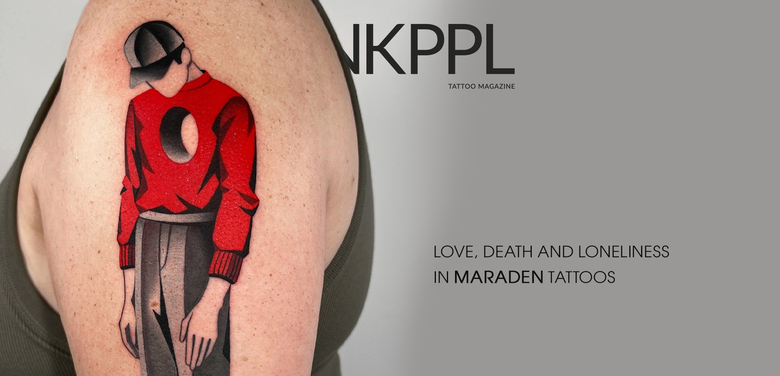



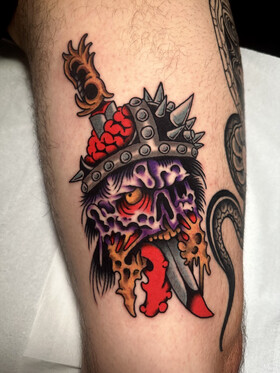
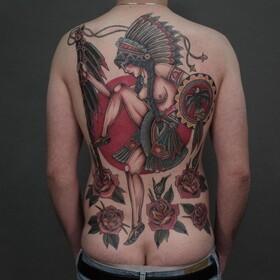
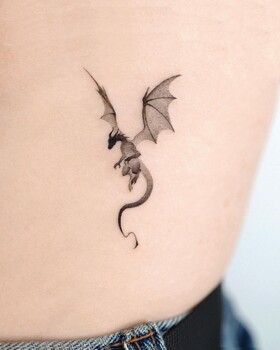
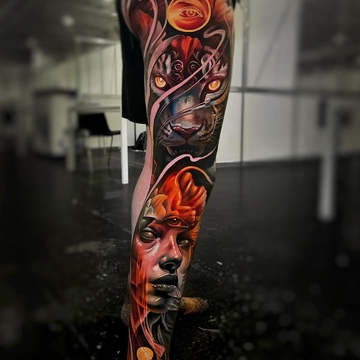
Comments (0)